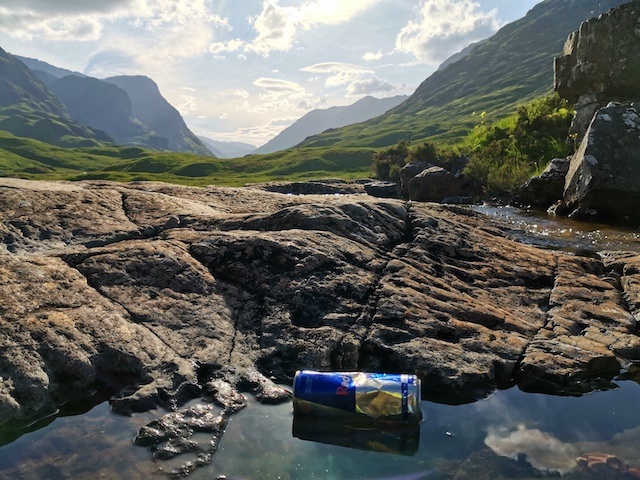A project which aims to empower tourists to explore Glencoe and Glen Etive responsibly is set to receive vital funding to help balance the needs of visitors, local people and the landscape.
The Sustainable Visitor Infrastructure project, run in partnership by the Highland Council, the National Trust for Scotland and Glencoe and Glen Etive Community Council, has been awarded £375,000, subject to conditions, in Round Three of the Rural Tourism Infrastructure Fund (RTIF).
The project will be boosted by contributions from project partners, including £100,000 from the National Trust for Scotland.
Launched by the Scottish Government in 2017 and administered by VisitScotland, the RTIF has so far invested £9million in infrastructure at scenic areas and popular rural tourist spots.
The Sustainable Visitor Infrastructure project in Glencoe and Glen Etive is one of 13 initiatives across Scotland to receive support in this third round of funding.
It aims to make the community and landscape more resilient to rising visitor numbers with more fit-for-purpose parking, paths for walkers and visitors, signage and waste disposal facilities.
Glencoe and Glen Etive are two of Scotland’s most well-known and well-loved natural wonders.
Much of the area is a National Nature Reserve, recognised for its wildlife and precious habitats, and cared for by the National Trust for Scotland.
Around two million vehicles travel through the Glens on the A82 each year and this places pressure on the environment and local people.
The largest element of the project will be an upgrade of Glencoe’s busiest parking areas beside the A82 at the iconic Three Sisters viewpoint.
A busy stop-off for photographs and access point to the popular Coire Gabhail or Hidden Valley walks and other mountain hikes, demand for these car parks often leads to irresponsible parking and hazardous driving.
The planned improvements will maximise vehicle capacity within the existing car park footprint, marking out a safe and efficient layout.
An all-ability path will replace an existing informal trail to a viewpoint near the Coire Gabhail parking area, helping to safely separate pedestrians from vehicles and reducing the impact of thousands of feet on the sensitive hillside habitat.
Other parking hotspots likely to receive attention include Altnafeadh, where the West Highland Way climbs up the Devil’s Staircase and Glen Etive, including the popular view made famous in the James Bond movie, Skyfall.
A key element of the project is the construction of purpose-built visitor waste hubs at four locations in the glens, either upgrading existing amenities or providing new facilities.
While visitors will be encouraged to take their litter home, new signs in popular car parks will include local facilities maps showing where the nearest waste hubs, public toilets and local motorhome waste disposal sites can be found.
Improvements to footpaths include an upgrade of the trail from Glencoe village towards the Clachaig Inn.
The community is also exploring the establishment of a park-and-ride, hop-on, hop-off shuttle bus service, and the creation of the ‘Glencoe Greenway’, a traffic-free route that would link the Glens with the National Cycle Network’s nearby Caledonia Way.
Emily Bryce, the National Trust for Scotland’s Operations Manager for Glencoe said:
“We are delighted to have been earmarked for this funding.
“It will enable us to invest in positive, sensitive infrastructure improvements to make visiting this area a better, more sustainable experience for everyone.
“Over the last few years we have worked together on the challenges we share as a result of a growing number of visitors. We are now keen to take a step forward with solutions.
“While a significant proportion of the funding will be directed towards improved parking, the reality is that it would be near impossible to meet peak parking demand at the height of the season without tarnishing the landscape everyone comes to enjoy.
“So, while the interventions we seek here will make safe, sustainable improvements to parking provision, the over-arching, long-term strategy is to balance vehicle access with attractive alternatives to access by car.”
Viki Sutherland, Chair of the Glencoe and Glen Etive Community Council continued:
“After lockdown ended in 2020, we experienced one of our busiest ever summers and this brought into sharp relief some long-standing issues.
“Together we have mapped hot spots for over-parking, littering and anti-social camping between Glencoe village and the Glencoe Mountain Resort, and developed an action plan to help accommodate everyone who wishes to visit our stunning area.”
The project has been informed by local collaboration, extensive traffic monitoring and the results of an online survey.
The survey was launched on social media to gather views on the current challenges in the Glens and test ideas for how best to address them.
Over 3,000 people completed the questionnaire, spending an average of 18 minutes doing so and providing the equivalent of 945 hours of feedback.
It is one of the most extensive and detailed surveys of public opinion on outdoor access and visitor behaviour in Scotland in recent years.
Emily Bryce explains:
“We were keen to focus on positive and practical solutions to address issues of littering, dirty camping, road safety and parking capacity.
“We provided a range of suggestions and asked for respondents to rate them and share their ideas too.
“We got over 6,000 comments in total which showed us just how much passion people feel for this place and their shared concern for the challenges we face.”
The Glencoe and Glen Etive RTIF project hopes to be ready to begin the introduction of new facilities and infrastructure improvements in autumn and winter 2021.
Find out more about Glencoe National Nature Reserve here
In line with Scottish Government Covid-19 restrictions, the visitor centre at Glencoe remains closed.



